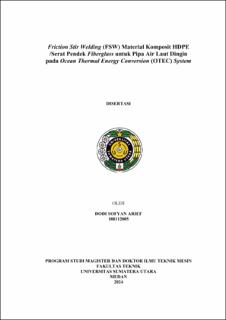Friction Stir Welding (FSW) Material Komposit HDPE /Serat Pendek Fiberglass untuk Pipa Air Laut Dingin pada Ocean Thermal Energy Conversion (OTEC) System
Friction Stir Welding (FSW) HDPE/Fiberglass Short Fiber Composite Material for Sea Water Cold Pipes on Ocean Thermal Energy Conversion (OTEC) Systems

Date
2024Author
Arief, Dodi Sofyan
Advisor(s)
Wirjosentono, Basuki
Koto, Jaswar
Metadata
Show full item recordAbstract
Cool Water Pipe (CWP) is very necessary in ocean-based Ocean Thermal Energy Conversion (OTEC) to channel cold water with a temperature of 5 °C from a depth of > 500 m to the condenser to liquefy the ammonia so that the OTEC system can produce electrical energy. The most appropriate CWP material used in ocean-based OTEC is High Density Polyethylene (HDPE) polymer composite reinforced with short fiberglass because it is flexible, light, corrosion resistant, low heat conductivity and does not burden the OTEC plant compared to using metal materials. When making composite pipes with a length of > 500 m, a joining process is required. Because it is not possible to produce pipes with a length of > 500 m in one production run, and it also makes transportation and installation difficult in the middle of the deep sea. Therefore, pipe connections must be made every 12 m until a pipe with a length of 500 m is formed using a friction stir welding (FSW) system. To produce the most optimal connection in terms of strength and microstructural composition of the composite material, this research carried out welding equipment design and varying welding parameters, namely rotational speed, welding speed and welding temperature to obtain the most appropriate welding results in durable cold water pipe applications. to sea currents. Friction rotary welding is carried out with rotational speeds of 600 rpm, 800 rpm and 1000 rpm, at temperatures of 130°C, 150°C and 170°C and welding speeds of 5 mm/minute and 10 mm/minute with an emphasis on flattening the welding surface of the melted High Density Polyethylene (HDPE) pipe, as well as to increase the strength of the connection. Welding is carried out by applying heat through the shoulder and adding external heat to the track before welding. The research results show that welding by applying external heat in front of the welding path provides better results compared to using a heat source only from the probe/pin. Furthermore, welding with FSW at a rotational speed of 800 rpm, welding speed of 5 mm/min, and temperature of 130°C has a success rate of 94.53% with a tensile strength in welding of 24.52 MPa and without welding it has a value of 25.94 MPa. As a comparison, welding pure HDPE with FSW has a success rate of 86.8%. Temperature greatly influences the success of welding, with higher welding temperatures causing voids and fiber buildup, which ultimately reduces the strength of the composite. ANOVA analysis shows that temperature has the greatest influence, followed by rotational speed and welding speed on the tensile strength of HDPE composite joints reinforced with short fiberglass. Based on simulations of applying seawater current loads to pipes with a length of 500 m and a diameter of 4 m, it is recommended to use pipes with a thickness of 22 cm, so that stress distribution is more even at the joints or stress concentrations do not occur at the joints.
